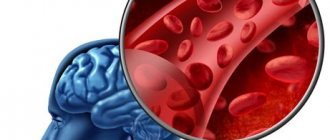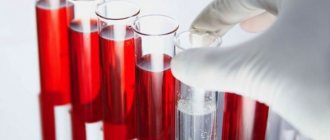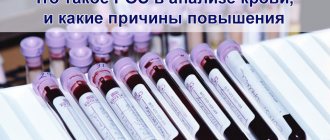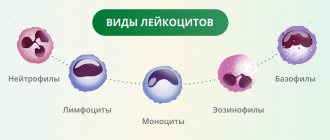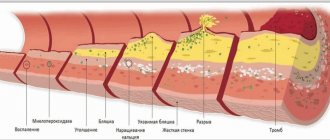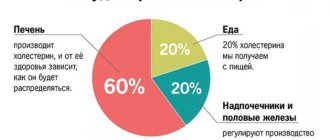Iron deficiency
9624 January 29
IMPORTANT!
The information in this section cannot be used for self-diagnosis and self-treatment.
In case of pain or other exacerbation of the disease, diagnostic tests should be prescribed only by the attending physician. To make a diagnosis and properly prescribe treatment, you should contact your doctor. We remind you that independent interpretation of the results is unacceptable, the information below is for reference only
Hemoglobin: indications for use, rules for preparing for the test, interpretation of results and normal indicators.
What is hemoglobin
Hemoglobin is a protein found in red blood cells. This element acts as a connecting link in metabolism, as it transports oxygen to all internal structures of the body and removes carbon dioxide from them. In addition to helping tissues “breathe,” the protein performs a pigment function, in other words, it gives the blood fluid a red tint.
Fluctuations in the required level of hemoglobin in the blood may indicate a pathological or some kind of stressful condition.
If any changes in the amount of hemoglobin are detected, patients are sent for additional studies, which help to reconstruct a complete clinical picture, and also allow one to diagnose/refute the presence of possible diseases.
Table of hemoglobin norms in the blood of women by age
Women experience many different hormonal changes throughout their lives, which are treated by an endocrinologist. They may be associated with physical overexertion, frequent stress, pregnancy, menstruation or menopause. For these reasons, enzyme concentrations may vary throughout the month and do not indicate the presence of any pathological processes in the body. In addition, depending on the age of the patient, protein levels will also vary.
Nowadays you can find a lot of information on the Internet regarding the norms of various blood parameters, including hemoglobin. The figures indicated there are far from the real situation. The medical guidelines used by doctors indicate clear ranges - the minimum and maximum of each indicator. There is "from and to" for all ages. To treat the patient and determine the further prognosis. For hemoglobin, both the upper and lower limits of normal are important
The standard hemoglobin level in women varies from 120 to 150 g/l. You can evaluate the results of the analyzes by checking the indicated values with the tabular data.
Hemoglobin norm in women - table by age:
| Woman's age | Hemoglobin norm, g/l. |
| 17 — 20 | 120 — 150 |
| 21 — 30 | 120 — 150 |
| 31 — 40 | 120 — 145 |
| 41 — 50 | 120 — 140 |
| 51 — 60 | 120 — 140 |
| 61 — 65 | 120 — 140 |
| more than 65 | 120 — 150 |
Normal hemoglobin level in women aged 30–40 years
The norm at 40 years is at its highest level, after which it gradually begins to decline. Such modifications are associated with hormonal changes in the body that begin to occur during this period. The process of minimizing the concentration of the enzyme in the blood continues throughout subsequent years. Compared to thirty-year-old women, at 40 years old the protein content decreases by 5 g/l.
Normal after 50 years
After 50 years, the norm of hemoglobin in the blood of women decreases noticeably . These modifications can be clearly seen in the table; the indicated indicators do not correspond to normal values. Such disorders are associated with hormonal and emotional instability. Women at this age are susceptible to depression, various experiences) and quickly get tired even with minimal physical exertion (the help of a psychologist can help cope with such conditions.
Normal for women after 60
As indicated in the table, the hemoglobin level in women after 60 years of age becomes critical. This situation is associated with the end of menopausal changes and the minimization of metabolic processes in the body. Hemoglobin in women after 65 years of age has critical indicators, as internal metabolism in tissues slows down.
Hemoglobin loss
White bloods survived the loss of hemoglobin genes quite a long time ago. Molecular analysis shows that in almost all icefish, one mutation led to the loss of the gene encoding the β chain and part of the α chain of hemoglobin. The loss of the ability to synthesize hemoglobin caused the development of compensatory changes: the volume of the heart and total blood volume increased (approximately 3.5 times compared to teleost fish of a similar size) [13–15]. Scientists, having analyzed the DNA of representatives of nototheniid fish, came to the conclusion that only one species of whitefish (Neopagetopsis iona) has hemoglobin genes, but they are not functional [16].
Along with hemoglobin, white bloods also lack myoglobin, which carries oxygen in skeletal muscles. Moreover, in ten species, myoglobin was preserved only in the cardiac muscle (in particular, in the ventricle) [17], and in six species, myoglobin was lost there as well, and the mechanism of gene loss is individual in each species [18]. A common mechanism for such loss is duplication of short (5–25 nucleotide) fragments, leading to a reading frame shift, premature termination of transcription, the appearance of a false polyadenylation signal, or impaired binding of RNA polymerase to the promoter region of DNA [19], [20].
The loss of hemoglobin was initially supposed to be an adaptation to cold: it is known that the solubility of oxygen in cold water is higher [21], which means that the need for hemoglobin, on the contrary, is less. The absence of red blood cells also reduces blood viscosity, which is especially critical in extremely low temperature conditions. During the process of evolution, whitebloods have undergone quite radical changes to compensate for the loss of hemoglobin, including twice the energy expenditure for pumping blood compared to other fish [22].
Ice fish evolved from a sedentary, bottom-dwelling ancestor. In the cold, well-mixed, oxygen-rich Antarctic waters, fish with low metabolic rates can survive even without hemoglobin. In the middle of the Tertiary period, the ecological crisis in the Southern Ocean caused by cooling [23] led to the emergence of vast empty ecological niches. The lack of competition allowed mutants lacking hemoglobin to leave behind offspring that populated empty habitats. The cubs developed mechanisms to compensate for mutations. Relatively isolated fjords developed habitats that were colonized by multiple individuals, resulting in six species of fish that were isolated from each other and independently lost their globin genes [22].
Histologically, it has been shown that a feature of ice fish is a high volume of mitochondria with a similar number and a high lipid/protein ratio in mitochondrial membranes in comparison with closely related species of the nototheniid fish family (Fig. 4). Interestingly, in white blood, which lacks myoglobin in skeletal muscle but is present in cardiac muscle, the volume of mitochondria in skeletal muscle is significantly higher than in the myocardium. Very little is known about the molecular mechanisms of this phenomenon. Presumably, this phenomenon is associated with one of the key protein regulators of mitochondrial biogenesis, PGC-1α [23].
PGC-1α is a transcriptional coactivator and central to mitochondrial formation in cells. Recently, it was discovered that PGC-1α regulates the composition and function of individual mitochondria and their oxidative metabolism. Increased oxidative metabolism is associated with increased PGC-1α activity, which is accompanied by an increase in reactive oxygen species (ROS) in mitochondria. But this protein is also a powerful regulator of ROS removal, because high levels of PGC-1α trigger the expression of numerous antioxidant enzymes [25].
Figure 4. Cross-section of myocytes of the ventricles of the heart (C. aceratus). Large mitochondria ( Mt ) are surrounded at the periphery by myofibrils ( My ).
[24]
The regulator of mitochondrial membrane biogenesis in whitebloods is nitric oxide-II (NO) (Fig. 5). Compared to other fish, white bloods have an increased level of this signaling agent in the blood. In response to the loss of hemoglobin and myoglobin in the muscles of icefish, the biosynthesis of phospholipids increases, and, independently of the synthesis of mitochondrial proteins and the replication of mitochondrial DNA, this leads to an increase in the size of mitochondria. The NO molecule stimulates the formation of PGC-1α, which regulates mitochondrial DNA replication. But nothing is known about how mitochondrial phospholipid biosynthesis is integrated into this process in icefish; this may be induced by high levels of NO (dark arrow in the figure) [18].
Figure 5. Process of mitochondrial biogenesis in icefish. Mitochondrial formation involves the synthesis of mitochondrial proteins (blue dots), phospholipids, and replication of the mitochondrial genome (green circles). In response to stimuli such as decreased temperature (or increased exercise stress in mammals), these three components of mitochondrial biogenesis are concertedly activated, resulting in increased mitochondrial density.
[18]
Table of hemoglobin norms in men by age
In men, the concentration of hemoglobin in the blood differs significantly from the normal values of the enzyme in women. So, in the male half, its content should not decrease to 130 g/l. and rise above the level of 170 g/l.
Such differences are associated with the production of testosterone in men, which can further enrich blood cells with oxygen.
In addition, the energy costs of the stronger sex are larger, which means the need for air exchange increases.
The norm of hemoglobin in the blood of men, depending on age, is shown in the table:
| Age | Normal hemoglobin g/l. |
| 15 — 18 | 120 — 155 |
| 18 — 30 | 130 — 170 |
| 30 — 40 | 130 — 155 |
| 40 — 60 | 130 — 160 |
The hemoglobin level in men after 30 years gradually begins to decrease. These differences can be analyzed using the table. Such changes are directly related to testosterone production.
As you know, after 40 years, the production of the hormone decreases, and therefore, male libido is gradually suppressed (consultation with a sexologist can solve this problem)
Against the background of ongoing processes, the physical activity of a man is similarly minimized.
In men after 50–60 years, the concentration of the enzyme is minimized, since testosterone virtually ceases to be produced. Therefore, it is regularly necessary to monitor the indicators of blood components and undergo tests. Any deviation from normal values (as indicated in the table) should be immediately eliminated, since at this age there is a high risk of developing anemia and other pathologies associated with the abnormal composition of the blood fluid.
Prevention of anemia
To prevent the development of anemia, it is necessary:
- avoid contact with poisons and toxic substances;
- refuse to visit areas contaminated with radiation;
- do not contact with sources of ionizing radiation;
- do not take medications uncontrollably;
- to harden;
- eat right, include meat, greens, fruits and vegetables in your daily diet;
- spend more time outdoors.
Secondary prevention of low hemoglobin includes:
- blood test once a year;
- seeking qualified medical help in the event of acute infectious and viral diseases;
- annual medical examinations;
- pregnancy planning (for women).
This article is posted for educational purposes only and does not constitute scientific material or professional medical advice.
Table of hemoglobin norms in children by age
In newborns, the density of hemoglobin in the blood has maximum values. Then its content gradually decreases, a certain stability of indicators appears only at 6 months. This condition persists until the child reaches 5 years of age, after which the concentration of the enzyme begins to increase again.
It is also worth considering that when a child reaches the age of 12 years, it is necessary to analyze protein indicators based on his gender. They will be different for boys and girls.
The norm of hemoglobin in the blood of children by age is shown in the table:
| Age | Boys | Girls |
| from 0 to 15 days. | 160 — 200 | 160 — 200 |
| 1 - 3 months | 120 — 160 | 120 — 160 |
| 4 - 6 months | 95 — 140 | 95 — 140 |
| 6 – 12 months | 110 — 145 | 114 — 150 |
| 1 - 2 g. | 110 — 130 | 110 — 130 |
| 2 - 5 l. | 105 — 150 | 105 — 145 |
| 5 - 11 l. | 110 — 140 | 110 — 140 |
| 12 - 14 l. | 120 — 140 | 120 — 140 |
| 15 - 17 l. | 120 — 155 | 120 — 150 |
Normal hemoglobin level in blood during pregnancy
During pregnancy, a woman’s amount of enzyme in her blood will differ from the values indicated in the table above. Also, pregnant women should know what medications can and cannot be taken during pregnancy. These deviations are associated with various changes that occur in the body.
Approximate indicators of enzyme content in pregnant women are shown in the table:
| Trimester | Amount of hemoglobin g/l. |
| 1 | 115 — 165 |
| 2 | 110 — 145 |
| 3 | 110 — 140 |
These differences are associated with the end of menstruation and the subsequent growth of the placenta, which requires constant nutrition. Therefore, it is important for the expectant mother to systematically undergo blood tests, since a critical decrease/increase in hemoglobin can become a source of dangerous complications (hypoxia, abnormal fetal development, early birth, underweight of the baby, retardation in mental/physical development, etc.).
Doctor's advice
Often the cause of increased hemoglobin is non-compliance with the drinking regime. The body receives little fluid (less than 1.5-2 liters of clean water per day, tea, coffee and other liquids do not count), this causes the blood to thicken. In this condition, not only hemoglobin, but other indicators also increase - hematocrit, red blood cells, platelets. Hematologists advise that if you have anemia, your diet should focus on meat. Liver and buckwheat are in second place in importance. Next are apples, nuts, cocoa. These same principles apply not only to adults, but also to children.
Victoria Druzhikina Neurologist, Therapist
Causes
Hemoglobin levels are influenced by many different factors. Basically, its decrease is typical for situations in which there is a decrease in the number of red blood cells or the occurrence of iron deficiency, disturbances in its absorption and transportation. This is observed when:
- bone marrow pathologies, including leukemia, aplastic anemia, lymphoma;
- renal failure, since when the quality of kidney function decreases, the synthesis of erythropoietin, which is necessary to activate the synthesis of red blood cells, is disrupted;
- uterine fibroids, since they often cause heavy intermenstrual bleeding;
- endometriosis;
- abnormally heavy, prolonged menstrual bleeding;
- hemorrhoids;
- hidden bleeding, in particular characteristic of gastric and duodenal ulcers, erosive esophagitis, ulcerative colitis, chronic pyelonephritis, urolithiasis and a number of other diseases;
- autoimmune, some infectious diseases leading to a shortening of the life of red blood cells and/or disruption of iron transport by the transferrin protein, including tuberculosis;
- systemic vasculitis, systemic lupus erythematosus;
- sickle cell anemia - a hereditary pathology in which red blood cells are shaped like a sickle rather than a biconvex disc;
- thalassemia is a hereditary disease in which the process of globin formation is impaired to varying degrees;
- oncological diseases;
- allergic diseases;
- helminthic infestation;
- liver diseases, especially cirrhosis, hepatitis;
- celiac disease;
- hypothyroidism;
- cystic fibrosis;
- hereditary spherocytosis;
- lack of the G6PD enzyme, etc.
Therefore, it is important to have a blood test regularly, at least once a year. This will allow us to detect pathological changes in the body at the earliest stages, perhaps even in the absence of any symptoms, and begin treatment.
Hemoglobin level in women during menstruation
During the menstrual period, protein content decreases sharply. This feature of the female body is associated with loss of blood fluid and is not a sign of pathology. It is for this reason that women feel unstable during menstruation:
- dizziness occurs (about other causes of dizziness here);
- appetite increases;
- there is a persistent feeling of fatigue, etc.
At the same time, experts recommend refraining from taking blood tests a few days before/after menstruation, as the information will be distorted. The normal level of hemoglobin after menstruation is restored within 2 – 3 days (with correct nutrition and lifestyle).
Consequences of decreased hemoglobin levels
Since the main function of hemoglobin is to ensure the respiration of all cells of the human body, its deficiency can lead to oxygen starvation or hypoxia. In addition, prolonged lack of hemoglobin provokes the development of:
- chronic fatigue syndrome;
- damage to the heart muscle with the development of myocardial dystrophy, and subsequently heart failure;
- decreased immunity, which increases the risk of acute respiratory infections, infectious diseases of various kinds, and exacerbation of existing chronic diseases;
- liver dysfunction;
- difficulties with conception and pregnancy due to deterioration of the reproductive system and menstrual irregularities;
- disorders of the nervous system with increased irritability, tearfulness, decreased memory, attention, etc.
Mostly, complications develop when stable low hemoglobin persists for more than 5 years.
One of the most severe consequences that can result from long-term low hemoglobin is hypoxic coma. This is accompanied by severe paleness of the skin, convulsions, and loss of consciousness. This is rare, but still not impossible. But hypoxia in any case has an extremely negative effect on the condition of the whole organism and greatly complicates the course of such chronic diseases as coronary artery disease and bronchial asthma. It can also cause myocardial infarction and stroke. Therefore, it is important to promptly diagnose not only a decrease in hemoglobin, but also the reasons for the decrease in its level in the blood and take measures appropriate to the situation.
It is very important to regularly monitor hemoglobin levels during pregnancy, since a lack of it can lead to complications during pregnancy, as well as disturbances in fetal development. Thus, with low hemoglobin, the likelihood of premature birth, decreased contractility of the uterus, delayed fetal growth and intellectual development, and disturbances in the functioning of the nervous and respiratory systems increases sharply.
A persistent decrease in hemoglobin levels is especially dangerous for children, as this can provoke the occurrence of delayed intellectual development.
Causes and symptoms of low hemoglobin
Iron deficiency anemia is a fairly dangerous and common condition in which the blood cell content is less than the lower limit of normal.
In this case, the patient may have the following symptoms:
- vertigo;
- severe fatigue;
- change in taste preferences;
- frequent headaches (read how to get rid of headaches in this article);
- dyspnea;
- decreased blood pressure;
- decreased muscle tone;
- brittle nails/hair.
The danger of decreasing hemoglobin levels is that the brain and other internal structures do not receive the required amount of oxygen, and therefore cease to function correctly. As a result, associated health problems appear that significantly affect the quality of life.
The main reasons for a decrease in hemoglobin in the blood:
- poor nutrition (frequent diets, lack of vitamins, etc.);
- chronic gastritis (here you can find effective tablets for stomach pain)
- chronic pyelonephritis;
- arthritis;
- hepatitis;
- dysbacteriosis;
- tuberculosis;
- blood loss (after operations, injuries).
Symptoms of anemia
Conventionally, the symptoms of low hemoglobin are classified into:
- specific (manifest only in specific types of anemia);
- nonspecific (the same for all types of disease).
Nonspecific symptoms of anemia are as follows:
- pallor of the skin/mucous membranes;
- migraine;
- increased fatigue;
- noise in ears;
- refusal of food;
- constant drowsiness;
- feeling of lack of air;
- dizziness;
- cardiopalmus;
- decreased libido, sexual impotence in men;
- disruption of the menstrual cycle;
- heart failure.
Specific signs of different types of anemia
Each type of anemia has its own specific symptoms. Thus, the acute posthemorrhagic form manifests itself:
- increased heart rate;
- fainting;
- cold sweat;
- attacks of dizziness;
- pale skin;
- decrease in body temperature.
In chronic posthemorrhagic anemia the following are observed:
- very white skin;
- craving for or intolerance to certain smells;
- swelling of the face;
- change in taste sensations;
- dry skin;
- brittle nails;
- nausea;
- lack of air;
- sweating;
- involuntary urination when sneezing or laughing;
- temperature increase.
Hemolytic anemias are characterized by:
- yellowness of the skin and mucous membranes (when red blood cells are destroyed, bilirubin enters the bloodstream);
- increased size of the spleen/liver;
- increased levels of bilirubin in the blood;
- darkening of urine and feces;
- high body temperature;
- weakness.
Sickle cell anemia - a type of hemolytic - has the following symptoms:
- jaundice;
- shortness of breath;
- formation of inflamed areas on the legs;
- blurred vision;
- the presence of hemoglobin in the urine.
Doctors diagnose thalassemia if the patient:
- the shape of the skull bones changes;
- the skin becomes very pale with a yellowish/greenish tint;
- eyes become narrow and swollen;
- there is a lag in mental/physical development;
- bones are deformed;
- the spleen/liver enlarges.
Signs of iron deficiency anemia include:
- buzzing in the head;
- lack of oxygen;
- migraine;
- constant desire to sleep, rest;
- dry skin;
- peeling of nails;
- hair section;
- desire to eat chalk, smell paint, etc.;
- violation of the act of urination;
- hyperhidrosis.
Also, during laboratory tests, it is discovered that the level of hemoglobin and red blood cells in the blood is significantly lower than the established norm.
B12 deficiency anemia affects the gastrointestinal tract and central nervous system. As a result, the patient experiences:
- swelling of the legs;
- crawling sensation on the arms/legs;
- change in gait;
- memory impairment;
- problems swallowing food;
- enlarged liver/spleen;
- drying of the gastrointestinal mucosa.
In turn, folate deficiency anemia manifests itself:
- inability to eat acidic foods;
- glossitis;
- difficulty chewing and swallowing food;
- enlarged spleen/liver;
- atrophy of the mucous membranes of the gastrointestinal tract.
The symptoms of hypoplastic anemia are:
- the appearance of ulcers in the mouth, on the skin of the face;
- bruising on the skin;
- severe bleeding gums;
- increased fatigue;
- desire to sleep;
- tachycardia;
- decrease in the number of leukocytes, red blood cells and platelets in a blood test.
If you experience similar symptoms, consult your doctor
. It is easier to prevent a disease than to deal with the consequences.
How to increase hemoglobin in the blood
It is important to control the ratio of all components of the blood fluid. Since its minimization is a pathological condition that will require certain treatment, and it does not always go away quickly and successfully. As therapy, doctors can take measures such as:
- blood transfusion (used in extreme cases, when the level is greatly reduced and drug treatment fails);
- prescription of vitamins (B9 and B12);
- taking iron-containing medications (in the form of tablets, suspensions or injections);
- drawing up a special menu (iron-enriched foods are added to the diet - meat, liver, herbs, vegetables, buckwheat, dried fruits, seafood, chocolate, etc.)
Therapy to increase hemoglobin levels in the blood is prescribed by a doctor during a personal appointment or online consultation. You can consult online or consult with a service doctor.
How to take a blood test for hemoglobin
To donate blood, no special preparation is needed, but there are rules that should be followed. Obtaining the most reliable result depends on them:
- hemoglobin test is taken in the morning on an empty stomach;
- the last meal is taken 10-12 hours before blood sampling;
- on the eve of going to the laboratory, it is recommended to avoid heavy physical labor, strenuous training, and stressful situations;
- Fatty foods and alcohol, which distort the data, must be eliminated from the diet within 24 hours.
To carry out the procedure, venous or capillary blood (from a finger) is taken. For prevention purposes, it is enough to undergo a test for hemoprotein levels once every 2-3 years.
High hemoglobin: causes, treatment
If hemoglobin levels in the blood exceed the norm indicated in the table, then this condition is also a reason to consult a doctor. In this case, the patient may have symptoms such as:
- problems in the functioning of the genitourinary system;
- drowsiness;
- yellowish skin;
- poor appetite;
- decreased vision;
- oncology;
- chronic heart failure;
- high fatigue.
The reasons for such a violation include:
- diabetes mellitus (the disease is treated by an endocrinologist);
- increased blood viscosity;
- erythrocytosis;
- excess vitamin B12/B9;
- chronic obstructive pulmonary diseases.
Frequently asked questions and doctor's answer
General practitioner Victoria Druzhikina answered questions
1. What is Hemoglobin indicated in a blood test?
- “In a general blood test, hemoglobin is abbreviated as Hb, measured in grams per liter.” 2. Why is low Hemoglobin dangerous?
– “Low hemoglobin levels are dangerous due to anemia and its consequences:
- oxygen starvation of organs and tissues, primarily nervous;
- muscle weakness;
- fainting due to decreased blood pressure;
- decreased immunity;
- wear and tear of the heart muscle due to the development of compensatory tachycardia in conditions of lack of oxygen;
- heart attacks;
- retardation in mental and physical development.
In severe cases, untreated anemia can lead to hypoxic coma and death due to brain or heart failure.”
3. Blood transfusion for low hemoglobin
– “To treat severe forms of anemia, blood or red blood cell transfusions are used. The procedure is indicated in 2 cases:
1. With a hemoglobin level of 70 g/l and below.
2. In case of poor tolerance to anemia and the threat of hypoxic coma at any level of hemoglobin. This can occur in people whose lives involve high oxygen consumption - pregnant women, athletes, scuba divers playing wind instruments.
The standard regimen is 2 doses (1 dose – 200 ml) twice a week. Before and after the procedure, general urine and blood tests and temperature must be monitored.
Before the manipulation, the patient’s blood type and Rh factor are determined, and donor blood is selected based on these indicators. Next, the compatibility of the blood samples is checked. If the reaction proceeds normally, a transfusion is performed. If flakes or clots form, this blood is not transfused, but other samples are tested for compatibility.” 4. Hemoglobin norm in children under one year old
– “The hemoglobin norm in children under one year of age is determined by physiological factors. By the end of the 1st month, the numbers are higher than in adults and amount to 160–200 g/l.”
5. How to increase Hemoglobin in a child?
“If anemia is detected, it is important to increase hemoglobin levels as soon as possible, especially in children. The main role in this belongs to drugs. Unfortunately, nutrition will not significantly increase the numbers. With the help of food, you can only slightly improve your performance and maintain it at this level.
Foods to increase hemoglobin in children:
- beef;
- buckwheat;
- cocoa;
- liver;
- apples;
- pomegranate;
- walnuts.
Drugs for the treatment of anemia in children:
- Maltofer;
- Ferrum Lek;
- Totema;
- Ferlatum and others"
6. How to increase hemoglobin during pregnancy?
“During pregnancy, it can be difficult for a woman to follow a diet with foods rich in iron. However, their list is quite wide, you can choose what you like:
- beef;
- wheat bran;
- hazelnuts;
- cabbage, including broccoli;
- chocolate;
- rabbit;
- liver;
- cocoa;
- apples;
- pears;
- parmesan, etc.
How to increase hemoglobin during pregnancy - the most used drugs:
- Maltofer;
- Sorbifer Durules;
- Ferrum Lek;
- Gyno-tardiferon;
- Totema;
- Ferlatum and others."
7. Iron supplements to increase hemoglobin in adults
– “To treat anemia in adults, the same drugs are used as for pregnant women. Can also be used:
- Venofer;
- Ferlatum protein;
- Cosmopher;
- vitamin complexes with iron (Ferro-Folgamma, Fenyuls, etc.).”
8. Normal Hemoglobin in Newborns? – “The hemoglobin norm varies slightly from month to month, the generally accepted average values are 120–160 g/l.
Immediately after birth, the mother’s blood circulates in the baby, so values from 180 to 240 g/l are considered normal for the 1st week of life.”
For information on hemoglobin levels, see also the video:
This article has been verified by a current qualified physician, Victoria Druzhikina, and can be considered a reliable source of information for site users.
Bibliography
1. The norms of indicators are indicated in Appendix No. 3 of Order of the Ministry of Health of the Russian Federation dated 09/14/2001 364 (as amended on 06/06/2008)
Rate how useful article
4.7 was. 29 people voted, average rating 4.7
Did you like the article? Save it to your wall so you don’t lose it!
Products that increase hemoglobin: not just meat!
Low hemoglobin levels can occur in people whose diet is unbalanced. How can you increase your hemoglobin level?
The daily requirement of an adult for iron is approximately 12 mg. The use of certain dietary supplements in addition to a balanced diet can become one of the sources of microelements for the body. Read more…
Taking dietary supplements in addition to a balanced diet can help avoid iron deficiency and decreased hemoglobin levels in the blood. Why is low hemoglobin level in the blood dangerous?
Chronic iron deficiency can lead to a decrease in hemoglobin, a protein that carries oxygen, in the blood and provoke the development of anemia. Measures to prevent iron deficiency anemia...
Lack of iron in the body can cause the development of iron deficiency anemia. How can you restore normal hemoglobin levels in the blood?
"Ferrohematogen" can be recommended as a dietary supplement to food as an additional source of iron, vitamins C, B6, B9 and copper. Find out the cost...
Dietary supplement Not a medicine.
Hemoglobin is the basis of red blood cells, the most important elements of blood. Few people think that our well-being, activity and even appearance depend on the level of its content in the blood. In order to maintain normal hemoglobin levels, you need to provide the body with sufficient iron. You can replenish iron deficiency naturally, without pills. But you need to know the list of products that increase hemoglobin and be able to combine them with each other.
Daily intake of iron to maintain physiological levels of hemoglobin in the blood
Blood carries and delivers oxygen to all cells of our body thanks to hemoglobin. It contains the bulk of all iron found in the human body. For example, a woman weighing 50 kg with normal hemoglobin contains 1.1 g of iron in her blood. Hemoglobin level is determined along with other indicators during a general blood test. A normal concentration is considered to be 130 g/l for men and 120 g/l for women.
For children, the hemoglobin norm depends on age:
- up to 2 weeks - 125–225 g/l;
- per month - approximately 100–180 g/l;
- from 2 to 6 months - 90–140 g/l;
- from 6 months to 2 years - 106–148 g/l;
- from 3 to 6 years - 103–143 g/l;
- from 7 to 12 years -111–146 g/l;
- from 13 to 16 years old - 112–153 g/l in girls and 118–164 g/l in boys;
- at 17–19 years old - 112–147 g/l in girls and 120–167 g/l in boys.
Iron requirements depend on a person's age, gender, weight, level of physical activity, and concomitant conditions such as pregnancy or recent blood loss.
A newborn has its own supply of iron, which is gradually used up. Therefore, the need for it at this time is small - only 0.27 mg. Gradually, the depot is depleted and for full development the child needs to receive about 11 mg of this microelement per day from food.
Until approximately 13 years of age, a child should receive 7 to 10 mg of iron. But with the onset of puberty, the situation begins to change dramatically. From now on, the required amount of iron for boys and girls will be different.
It is enough for teenage boys to get about 11 mg of this trace element per day. This amount is quite enough for their growing body. Girls at the same age need to receive up to 15 mg of iron. After all, they not only experience active growth and development of all internal organs, but also the formation of the reproductive system, and regular blood loss begins during menstruation.
After 19 years, men's need for iron decreases to 8 mg per day, while in women, on the contrary, it increases to 18 mg, and during pregnancy - to 27 mg per day. This is due to the physiological characteristics of the female and male body.
What causes hemoglobin to decrease and why is it dangerous?
The level of hemoglobin directly depends on the amount of iron in the body. The greater the consumption of iron and the less it comes from food, the higher the likelihood of developing anemia.
If the amount of hemoglobin decreases, the blood begins to carry less oxygen. The tissues are starved of oxygen, which can cause dizziness, frequent heavy breathing, fainting, or heart pain.
During pregnancy, hemoglobin levels are especially important. Anemia that occurs during this period increases the risk of toxicosis, gestosis, premature birth and miscarriage. When hemoglobin drops below normal, immune disorders, placental insufficiency occur, and fetal development is disrupted.
Figures and facts During pregnancy, about 1300 mg of iron is consumed.
During the period of growth, children's need for iron sharply increases, and if there is a lack of iron-containing foods in the diet, their hemoglobin may decrease. This leads to rapid fatigue, developmental disorders, and decreased academic performance. Therefore, if such signs appear, it is advisable to get tested.
Vegetarians are considered another risk group. Iron is not absorbed from plant foods as well as from animals, and getting your “norm” is quite difficult. In addition, many plant products containing large amounts of iron also contain substances that interfere with its absorption.
In older people, the decrease in hemoglobin levels does not manifest itself as in middle age. Instead of brittle nails, hair loss or dry skin, symptoms of iron deficiency such as shortness of breath, weakness and dizziness come to the fore. These symptoms are often attributed to age or heart disease. At the same time, changing your diet, taking dietary supplements or medications help correct hemoglobin deficiency and significantly improve your condition.
The main reasons that can cause hemoglobin deficiency are:
- increased need for iron, for example, during active growth or pregnancy;
- bleeding, including periodic and hidden;
- unbalanced nutrition or diets.
If in the first two cases you definitely need to consult a doctor about prescribing special medications, then in case of iron deficiency associated with nutrition, it is enough to adjust your diet.
What foods increase hemoglobin?
The production of hemoglobin requires amino acids and iron. It would seem that if you eat foods high in iron, this should solve the problem. But in reality it's not that simple.
The absorption of this microelement strongly depends on the acidity of gastric juice, on the condition of the intestines, on the combination of foods and the presence of certain substances in them. For example, about 15–20% of the iron found there is absorbed from meat, but no more than 1–5% from vegetables. This is why it is possible to raise hemoglobin with foods such as apples or pomegranates, but it will take a lot of time.
Beef “raises” hemoglobin best, chicken and turkey meat are a little less effective. Iron is absorbed worse from eggs and liver.
If you take plant foods that increase hemoglobin, carrots, potatoes, cabbage, broccoli, tomatoes, cauliflower and pumpkin work best. They contain large amounts of citric, malic and ascorbic acid, which help iron enter the body. But it is practically not absorbed from spinach, wheat (including bread) or lentils, since these products contain a large amount of phytins.
It is advisable to limit the intake of tea and coffee. They contain large amounts of tannin, which interferes with the absorption of iron. By drinking a large amount of strong tea, you can completely stop the flow of this microelement into the body.
How to increase the absorption of iron from food
In order for products that increase hemoglobin to be most effective, it is important to combine them correctly. To do this, you need to remember a few rules.
Increases the bioavailability of iron:
- ascorbic acid (rose hips, bell peppers, cauliflower);
- copper (liver, peanuts, buckwheat, cereals);
- folic acid (beef liver, cod liver, walnuts);
- citric and malic acid (citrus fruits, tomatoes, peppers);
- sulfur-containing amino acids (meat, fish, seafood);
- sugar.
Reduce the bioavailability of iron:
- calcium (dairy products);
- phytates (bread, legumes);
- milk and soy proteins;
- tannin (tea, coffee, pomegranate, persimmon);
- phosphates (canned foods, processed cheese, carbonated drinks).
If you know what foods you need to eat to increase hemoglobin, you can simply create a menu for yourself to prevent iron deficiency. It is especially important to take care of proper nutrition for children and pregnant women. And, of course, it is better to think about your health before the first signs of a decrease in hemoglobin appear.
Prevention of hemoglobin deficiency in the blood
Only a doctor can treat low hemoglobin levels, but everyone can prevent this condition.
We asked an expert to give some useful tips. “The most important prevention of anemia is to prevent iron deficiency in the body. A nutritious diet helps avoid this problem. But if iron consumption is increased, it is difficult to prevent deficiency. In this case, dietary supplements and special medical nutrition can come to the rescue.
Dietary supplements contain iron in a form that is easily absorbed. In addition, they often add substances that improve its bioavailability.
When choosing a dietary supplement, pay attention to its composition. It should not contain “extra” components, preservatives, confectionery or other additives. For children, it is better to choose supplements not in tablets, but in the form of syrup or sweet bars. Such as, for example, “Ferrohematogen”.
"Ferrohematogen" is made from natural, safe products without taste improvers. The product contains iron in its natural heme form, and is additionally enriched with vitamin C, B6, folic acid and copper. Thanks to this composition, iron is quickly absorbed and goes into hemoglobin synthesis.
Since Ferrohematogen contains no artificial additives, it can be taken even by children (from 3 years old) and pregnant women.”
PS More information about the product can be found on the website www.ferrogematogen.ru.
